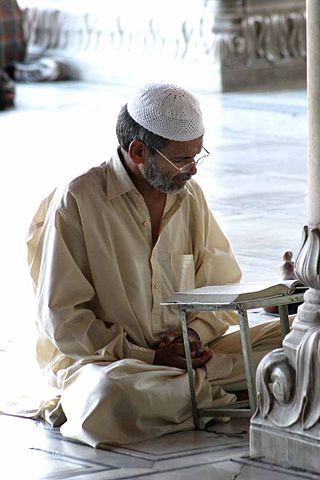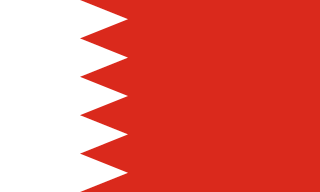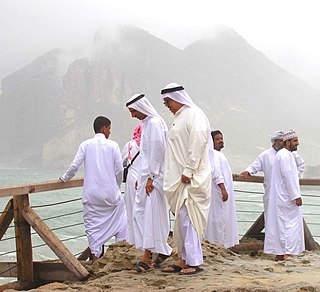
Manama is the capital and largest city of Bahrain, with an approximate population of 200,000 as of 2020. Long an important trading center in the Persian Gulf, Manama is home to a very diverse population. After periods of Portuguese and Persian control and a short invasion from the ruling dynasty of Saudi Arabia, followed by a longer invasion by Oman, Bahrain established itself as an independent nation in 1971 following a period of British hegemony.
Bahrain was a central location of the ancient Dilmun civilization. Bahrain's strategic location in the Persian Gulf has brought rule and influence from mostly the Persians, Sumerians, Assyrians, Babylonians, Portuguese, the Arabs, and the British.
The music of Bahrain is part of the Persian Gulf folk traditions. Alongside Kuwait, it is known for sawt music, a bluesy genre influenced by African, Indian and Persian music. Sultan Hamid, Ali Bahar and Khaled El Sheikh are among the most popular musicians from Bahrain.

Islam is the state religion in Bahrain. Due to an influx of immigrants and guest workers from non-Muslim countries, such as India, the Philippines and Sri Lanka, the overall percentage of Muslims in the country has declined since the late 20th century. Bahrain's 2010 census indicated that 70.2% of the population is Muslim. The last official census (1941) to include sectarian identification reported 16% as Shia and 84 per cent as Sunni of the Muslim population.

Arab-Persians are people who are of mixed Arab and Persian descent. Historically, inter-ethnic marriages between Arabs and Persians have been common in Iran, Kuwait, Iraq, and Bahrain, as well as in Lebanon and Syria, albeit to a lesser extent.
The Bahārna are an ethnoreligious group of Shia Muslim Arabs indigenous to the historical region of Bahrain. They are generally regarded to be the original inhabitants of Eastern Arabia. They inhabited the area even before the arrival of the Banu Utbah in the 18th century which the Bahraini royal family descends from. Most Bahraini citizens are Baharna. Regions with most of the population are in Eastern Arabia, with significant populations in Kuwait, United Arab Emirates, Qatar, Oman, Iraq, and Hormozgan province of Iran.

Bahrani Arabic is a variety of Arabic spoken by the Baharna in Eastern Arabia and Oman. In Bahrain, the dialect is primarily spoken in Shia villages and some parts of Manama. In Saudi Arabia, the dialect is spoken in the governorate of Qatif. In Oman, it is spoken in the governorates of Al Dhahirah and Al Batinah.

The Ajam of Bahrain, also known as Persian Bahrainis or Iranian Bahrainis, are an ethnic group in Bahrain composed of Bahraini citizens of Iranian ancestry.
Islam is historically divided into two major sects, Sunni and Shia Islam, each with its own sub-sects. Large numbers of Shia Arab Muslims live in some Arab countries including Lebanon, Yemen, Bahrain, Iraq, Saudi Arabia, Kuwait, Oman, the UAE, and Qatar.
Bahrain is a nation in the Persian Gulf, in a strategical position in relation to the eastern coast of the Arabian Peninsula, Iran, Iraq and Oman.

The Emiratis are the native citizen population of the United Arab Emirates. Within the UAE itself, they number approximately 1.15 million.

The Taqiyah, also known as tagiyah or araqchin, is a short, rounded skullcap worn by Muslim men. In the United States and the United Kingdom, it is also referred to as a "kufi", although the Kufi typically has more of an African connotation. Aside from being an adornment, the taqiyah has deeply ingrained significance in Islamic culture, reflecting the wearer's faith, devotion, and sometimes regional identity. While the taqiyah is deeply rooted in Muslim traditions, its use varies based on cultural context rather than strict religious guidelines.

Bahrain, officially the Kingdom of Bahrain, is an island country in West Asia. It is situated on the Persian Gulf, and comprises a small archipelago made up of 50 natural islands and an additional 33 artificial islands, centered on Bahrain Island which makes up around 83 percent of the country's landmass. Bahrain is situated between Qatar and the northeastern coast of Saudi Arabia, to which it is connected by the King Fahd Causeway. The population of Bahrain is 1,501,635 as of May 14, 2023, based on elaborations of the United Nations data, of whom 712,362 are Bahraini nationals. Bahrain spans some 760 square kilometres (290 sq mi), and is the third-smallest nation in Asia after the Maldives and Singapore. The capital and largest city is Manama.
Achomi, also called Khodmooni, Lari, or Larestani, are an Iranian sub-ethnic group of Persians who inhabit primarily in southern Iran in a region historically known as Irahistan. They are predominantly Sunni Muslims, with a Shia minority.
Shia Islam constitutes a significant minority in Kuwait. In 2001, the US Department of State reported that there were 300,000 Shia Kuwaiti citizens and 820,000 Kuwaiti citizens in total thus Shias formed 36.5% of the Kuwaiti citizen population. In 2002, the US Department of State reported that Shia Kuwaitis formed 30-40% of Kuwait's citizen population, noting there were 525,000 Sunni citizens and 855,000 Kuwaiti citizens in total. In 2004, there were 300,000-350,000 Shia Kuwaiti citizens and 913,000 Kuwaiti citizens in total. The Strategic Studies Institute reported that they constitute 40% of the population in 2008.
Huwala also collectively referred to as Bani Huwala, is a blanket term usually used to refer to Iranian Arabs of tribal lineage who initially migrated to Iran in the 13th and 14th century and intermixed with the indigenous population of older Arabic-speaking background. Such migrations continued till around 19th century to the area which is now Iran's Hormozgan Province and Fars Province, mainly Bandar Abbas, Qishm, and the mainland near Bandar Lengeh. The Huwala follows Sunni Islam, as opposed the majority Persian Twelver Shia and similar to Sunni Peninsular Arabs. Most of the Huwala have remigrated back to the Arabian Peninsula between late 19th century and early 20th century. The imposition of restrictive economic policies by Reza Shah in the 1930s led to the migration of most of the Huwala back to the Arabian Peninsula.

Kuwait and Iran have longstanding historical ties spanning hundreds of years, particularly in the pre-oil era. Relations were negatively influenced by the Iranian Revolution in 1979 and the Iran-Iraq War in the 1980s. Relations improved after the Iraqi invasion of Kuwait.
'Ajam of Kuwait are Kuwaiti citizens of Iranian descent. The majority of Shia Kuwaiti citizens are of Iranian descent, although there are Ajam Kuwaitis who are Sunni.

Thawb or thobe is an Arab dress for the inhabitants of the Arabian Peninsula, also called dishdashah, and kandurah, kandoora or gandurah in varieties of Arabic. A long-sleeved ankle-length traditional robe, it is mainly worn by men in the Arabian Peninsula, Jordan, Syria, Palestine, Lebanon, North Africa, and some countries in East and West Africa, with regional variations in name and style. It is also worn by Muslim men in the Indian subcontinent due to its modest appearance, and is referred to as jubbah. Depending on local traditions, a thawb can be worn in formal or informal settings; in the Gulf states thobes are the main formal attire for men. The term "thobe" is also used in some varieties of Arabic to refer to women's attire, such as in Palestine and Sudan.
Bahraini Gulf Arabic is a Gulf Arabic dialect spoken in Bahrain. It is spoken by Bahraini Sunni Arabs and is a dialect which is most similar to the urban dialect spoken in Qatar, the dialect spoken in Kuwait and Iraq.












